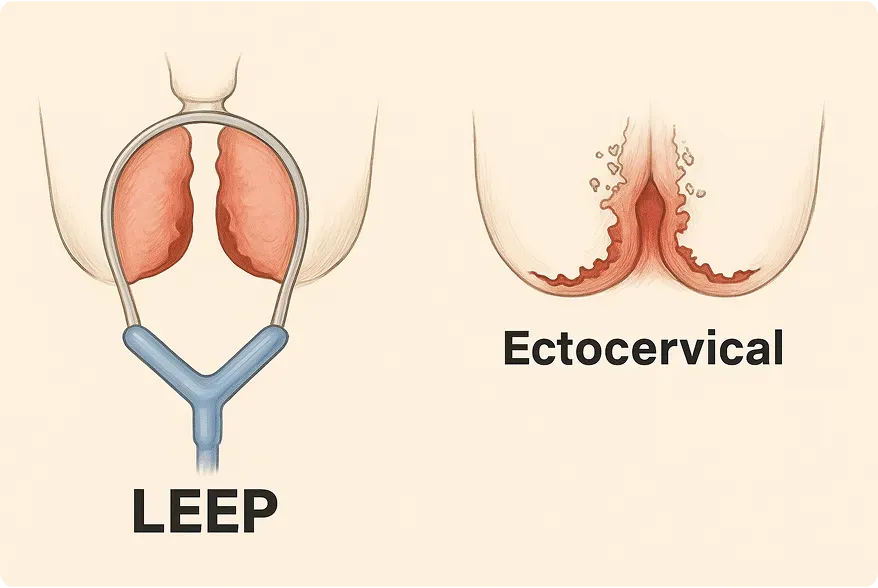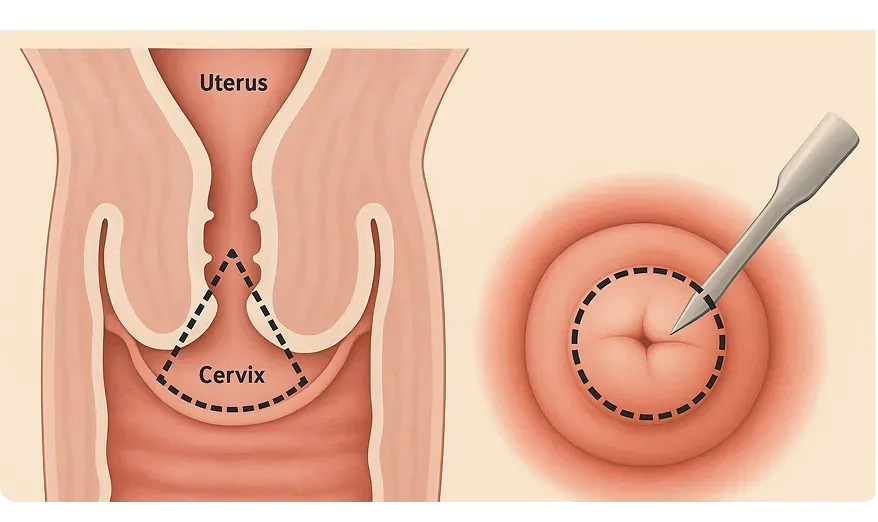Treatments
Cervical Conization & LEEP Procedures
Preserving Your Health — Without Sacrificing Your Future
Dr. Lucas Minig – Minimally Invasive Surgery Expert care for women with pre-malignant or early cervical cancer.
Request Consultation or Second Opinion

A Cervical Diagnosis Can Be Scary — But You Have Options
Abnormal cervical cells or high-risk HPV results can feel like a threat to your future. The truth? Most women with early detection don’t need aggressive treatment — just expert guidance.
At our center in Valencia, Dr. Lucas Minig and his team specialize in gentle, fertility-preserving solutions like cervical conization and LEEP. These procedures are safe, effective, and designed to remove only what’s necessary — helping you move forward with clarity and confidence.
You Shouldn’t Have to Choose Between Protection and Preservation
Cervical conization is often the first step in treating pre-cancerous or early-stage cervical abnormalities — especially for women who want to preserve their fertility.
With the right approach, most women go on to live full, healthy lives — and can still become mothers in the future. Our approach focuses on removing the least amount of cervical tissue necessary while ensuring long-term health.
Patients from around the world trust our expertise to treat even the most complex cases that local providers may not manage.
What Is Cervical Conization — and When Is It Needed?
Cervical conization
Cervical conization is a minor surgical procedure that removes a small cone-shaped portion of the cervix. It’s used to treat:
- High-grade dysplasia (CIN II/III)
- Persistent HPV-related abnormalities
- Precancerous changes that haven’t resolved
- Early-stage cervical cancer (IA1–IB1)
We’ll guide you step by step — from evaluation to follow-up care — always with a focus on fertility and long-term healing.
Three Techniques, One Goal: Gentle, Targeted Care

LEEP (Loop Electrosurgical Excision Procedure)
Best for superficial lesions or small biopsies. Uses a fine wire loop and electrical current to remove abnormal tissue.

Cold-Knife Conization
Performed with a scalpel for deeper or larger lesions. Slightly higher bleeding risk, used in highly selected cases.
Laser Conization
Uses a CO₂ laser for precision removal with minimal damage to healthy tissue. Ideal for delicate areas or fertility preservation.
Each technique is chosen based on your individual needs — lesion size, fertility goals, and the extent of disease.
When Is Fertility-Sparing Care Possible?
Fertility-sparing treatments are most appropriate in early-stage cases of:
- Cervical cancer
- Endometrial (uterine) cancer
- Select types of ovarian tumors (including germ cell and borderline tumors)
Your eligibility depends on:
- The size and spread of your tumor
- Whether lymph nodes are affected
- Your general health
- Your personal wishes
This decision is never made lightly. We conduct full staging, biopsy, and imaging to evaluate if a conservative approach is possible—and safe.
Recovery timeline: What to expect
Most patients return home the same day. Here’s what healing looks like:
Day 0
Out of hospital
Day 1-3
normal activity. Small vaginal bleeding might be expected during 10 days
Weeks 1-2
No baths, tampons, or intercourse.
Week 3-4
Follow-up visit, healing check, possible Pap test.
After 4 weeks
Most resume full activities; pregnancy planning if wishes may resume after 3 months if cleared.
We provide personalized aftercare plans and virtual support to monitor your healing.
“At 32, I was diagnosed with cervical cancer. Dr. Minig performed a conservative surgery that allowed me to carry my daughter two years later. I never thought it was possible—but it was.”
— Sandra D., fertility-sparing patient, Valencia
Can I Still Get Pregnant After Conization?
Yes — in most cases. Many women conceive naturally after cervical conization. If your cervix has been shortened, we’ll monitor you closely during pregnancy and may recommend a cerclage to support the cervix.
Reduce the Risk of Recurrence
Dr. Minig recommends these preventive steps to support long-term cervical health:
- Get the HPV vaccine (even after treatment)
- Quit smoking to boost immune defense
- Use condoms to reduce reinfection risk
- Stay consistent with follow-ups and Pap tests
Why Choose Dr. Minig for Fertility-Sparing Cancer Care?
More than a clinic — we are your international partner in healing.
With over 20 years experience treating global patients, we offer personalized surgical care and full logistical support for those traveling to Valencia.
- Specialized Expertise: Specialist in fertility-preserving treatment and early intervention
- Minimally Invasive Excellence: Over 95% of our surgeries utilize laparoscopic or robotic techniques.
- Individualized Care: We align treatment with your pain tolerance, fertility desires, and lifestyle.
- Whole-Woman Approach: From surgery to nutrition and emotional well-being, we support every facet of your health.
- Industry-Leading Research & Innovation
- Global Reach: Personalized logistical support for international patients

International patient welcome
Whether you’re in Europe, North America, or beyond, our clinic offers:
Tele-Consultations in English, Spanish and Italian
Concierge Travel Assistance for visas, lodging, and local transportation
Flexible Scheduling to accommodate your time zone
Frequently asked questions
Will cervical conization affect my ability to get pregnant?
In most cases, no. Cervical conization typically preserves the majority of the cervix and does not prevent pregnancy. However, depending on how much tissue is removed, there may be a slightly higher risk of cervical insufficiency in future pregnancies. If you’re planning to conceive, we’ll tailor your treatment to protect fertility whenever possible and discuss options like cervical cerclage if needed.
What’s the difference between LEEP and cold-knife conization?
LEEP (Loop Electrosurgical Excision Procedure) uses a thin, heated wire loop to remove abnormal cervical tissue and is ideal for superficial lesions.
Cold-knife conization is performed with a scalpel and is typically used for larger or deeper lesions. It provides a clearer margin for pathology but may involve a slightly higher risk of bleeding. Both are outpatient procedures, and the choice depends on your diagnosis and cervical anatomy.How long is recovery, and what should I avoid?
Most women recover within 7–14 days. During this time, avoid sex, tampons, douching, baths, and swimming to prevent infection and allow the cervix to heal. Light spotting and cramping are normal. We’ll guide you on exactly when it’s safe to return to normal activity—and your first follow-up will ensure you’re healing well.
Ready for Relief? Let’s talk.
Whether you want our symptom kit, the patient guide, or to speak directly with Dr. Minig, we’re here for you.
